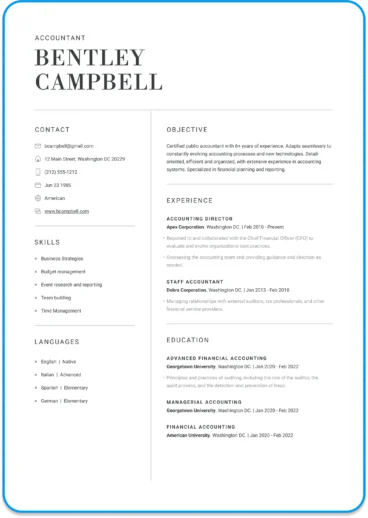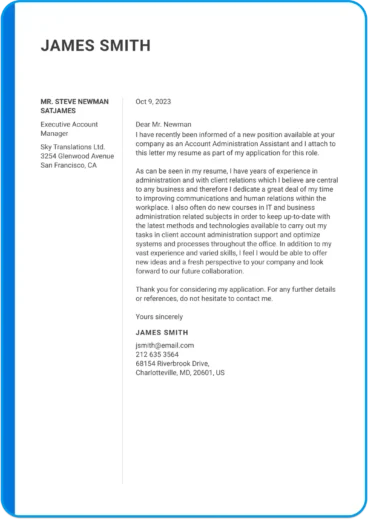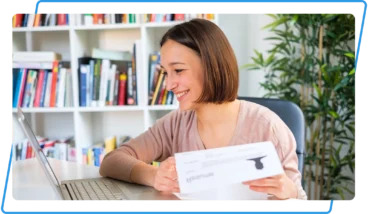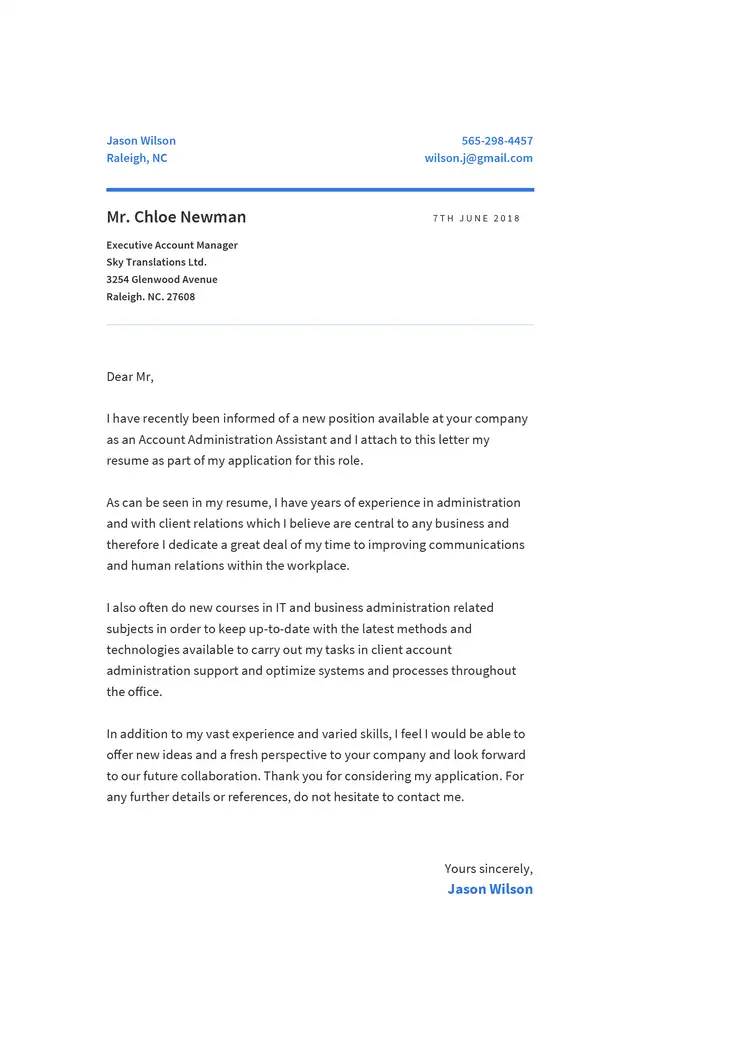Resume Templates
Resume samples

Create and edit your resume online
Generate compelling resumes with our AI resume builder and secure employment quickly.
Write a cover letter

Take a look at our cover letter guides and examples, to help you write a cover letter that complement your resume and enhace your applications.
Cover Letter Examples
Cover Letter Samples

Create and edit your cover letter
Use our user-friendly tool to create the perfect cover letter.
Featured articles
- How to Write a Motivation Letter With Examples
- How to Write a Resume in 2024 That Gets Results
- Teamwork Skills on Your Resume: List and Examples
- What Are the Best Colors for Your Resume?
Latests articles
- 10 Jobs for Extroverts To Succeed in
- How To Create a Winning Plain Text Resume: A Comprehensive Guide
- Should You Put Your GPA on Your Resume?
- What Is a Contractor: Definition and Examples

Dive Into Expert Guides to Enhance your Resume

What’s the Difference Between a Motivation Letter and a Cover Letter

If you’re thinking about applying to college or a new job and want to quickly show how motivated you are, you might looking for the best way to get that done.
Don’t worry, that’s normal, but you need a solution.
After all, when planning to apply for something, it’s essential to make a great first impression .
That’s why many applicants send in a cover letter or a motivation letter .
However, you might be wondering if there’s any difference at all between a motivation and a cover letter, and which one is better for the job you want to land ?
In this article, we’ll explain:
- Cover letter and motivation letter differences
- Benefits of each type of letter
- When to use one letter or the other
Once you understand which is best to include with your application, use our AI-powered resume builder to easily win over employers.
Keep reading to find out the best way to show off your career goals to employers.
Motivation vs. Cover Letter: Key Differences
Employers want to find and hire applicants who are highly motivated as it leads to a number of benefits for the company such as guaranteeing a great company culture and keeping the employee long term.
However, choosing between a cover letter or writing a motivation letter will depend on the type of program or company .
That’s because each letter focuses on different aspects of your qualifications and experience.
Take a look at the differences between the 2 types of letters :
Motivation Letter
- Centers on personal goals and passion for the field and is more personal and reflective, while discussing long-term aspirations.
Cover Letter
- Highlights professional skills and job suitability and is used for professional positions as it showcases relevant achievements and qualifications.
By picking the letter that best fits the position you want , you’ll guarantee that the hiring manager notices your best qualifications and goals.
Cover Letter vs. Motivation Letter: When to Use Them
There are a number of unique motivation letter and cover letter differences and strengths.
This means it’s critical to understand when to use those strengths , or you’ll end up explaining information that isn’t important.
For example, when applying for college or graduate school programs , you should use a motivation letter as it will help you show your passion for your field of study.
Here are other examples of when to use a motivational letter:
- Scholarship applications . Share how the scholarship will help you achieve your educational and career goals.
- Internships : Explain how you want to learn from experienced employees, especially in fields where your academic knowledge is essential.
- Volunteer positions : Mention your commitment and reasons for volunteering to an NGO or other organization that you would like to work with.
When to Write a Cover Letter
Cover letters focus more on your professional qualifications , so they should be used when sending your application to a company or business.
Here are some specific examples:
- When applying to a job : Use your cover letter to connect your experience and skills to the job’s requirements.
- Changing careers : Explain how your existing skills can transfer to the new role in your cover letter.
Even if it’s optional to send in a cover letter with your application, you should do so anyway.
It’s been proven that cover letters help candidates when applying for a position.
Between 2017 and 2021, there has been an 18% growth in the importance of including a cover letter with an application.
Cover Letter and Motivation Letter Differences in Format
Both cover letters and motivation letters differ a bit when it comes to their format. One is a bit longer, while the other is a bit more formal.
However, each letter will have an intro, body, and conclusion .
Cover letter format
If you’re writing a cover letter, you’ll want to keep it to 1 page and keep the vocabulary formal.
Your cover letter should cover the following in the different sections:
- Introduction : Briefly mention your current role or recent job and the position you’re applying for.
- Body : Mention your skills and achievements relevant to the job. Use examples to demonstrate your achievements and how they apply to the new role.
- Conclusion : Restate your interest in the position and invite the employer to review your resume or contact you for further discussion.
Here’s an example of a well written cover letter that mentions a candidate’s skills, accomplishments and more , so that you can better understand the format and style:
Dear [Employer’s Name],
I am writing to express my interest in the Accountant position listed on [Where You Found the Job Posting]. With a strong background in accounting principles and a commitment to accuracy and detail, I am excited about the opportunity to contribute to [Company Name].
In my current role at [Your Current Company], I have successfully managed a diverse range of accounting tasks, including ledger operations, financial reporting, and budgeting.
I am particularly proud of leading a project that streamlined our budgeting process, resulting in a 20% reduction in processing time.
I am eager to bring my expertise in financial management and my proactive approach to problem-solving to your team.
Thank you for considering my application. I look forward to the opportunity to discuss how my skills and experience align with the needs of your team. I am available at your convenience for an interview and can be reached at [Your Phone Number] or [Your Email].
[Your Name]
Motivation Letter Format
A motivation letter on the other hand can be a bit longer and more related to personal goals rather than professional ones.
Here’s what the different sections should go over:
- Introduction : Start with a personal statement or story that reflects your passion for the field or program.
- Body : Discuss your personal journey, long-term goals, and why the program or opportunity excites you. Include relevant personal achievements as well.
- Conclusion : Summarize your ambitions and how the opportunity aligns with your goals, expressing your desire to contribute and learn.
Here’s how your motivation letter can be formatted to show you are the best candidate for an internship position .
Dear [Recipient’s Name],
I am writing to express my enthusiasm for the [Specific Internship Position] at [Company/Organization Name]. My academic background in [Your Major/Field of Study] and my active involvement in [relevant clubs or activities] have fueled my interest in [specific aspect of the field or industry], making this internship an ideal opportunity for my professional growth.
During my studies at [Your University/College], I have developed [mention specific skills or knowledge relevant to the internship], which I am eager to apply in a practical setting
I am particularly attracted to this internship at [Company/Organization Name] because of your commitment to [mention something notable about the company or its values]. The chance to learn from and contribute to your team, especially in [mention a specific area or project of the company], is an exciting prospect for me.
Thank you for considering my application. I am looking forward to the opportunity to discuss how my background and enthusiasm make me a great fit for this internship.
When you write a cover letter or motivation letter, you’ll need to ensure your relevant qualifications and long-term goals shine .
You can do that if you remember the following:
- Motivation letters should be written for internships, organizations, and academic programs.
- Cover letters are more professional and should accompany a job application.
- Motivation letters are a bit more personal.
By using our handy cover letter builder , you can easily create a letter that will prove you are motivated and ready to take on your next challenge.

Trouble getting your Cover Letter started?
Beat the blank page with expert help.
Related blogs
Cover Letter Keywords That Can Make Your Document a Success Take your introduction to the employer to the next level with the most important cover letter keywords and phrases needed to create a successful impression. Updated on June 11, 2024 Cover Letter Keywords That Can Make Your Document a Success
How long should a Cover Letter be? The length of your cover letter is important. You want to show that you’re keen but you also need to keep it short and concise. Find out how to make it perfect! Reviewed Updated on October 9, 2024 How long should a Cover Letter be?
What Not to Put in a Cover Letter? Avoid common cover letter mistakes and start your job application correctly. Grab the hiring manager’s attention and land your dream job. Updated on June 11, 2024 What Not to Put in a Cover Letter?

10 Cover Letter Dos And Don’ts
October 18, 2024

Image Source
“We regret to inform you…” Five words that can shatter a job seeker’s hopes, often the result of an overlooked detail: a weak cover letter.
But here’s the silver lining: 94% of hiring managers say cover letters significantly influence their decision to interview candidates. Your cover letter isn’t just a formality—it’s your golden ticket to landing that dream job.
However, crafting a standout cover letter can be tricky. What makes hiring managers sit up and take notice? How do you strike the perfect balance between professional and personable? And in a sea of applicants, how do you ensure your letter doesn’t get lost in the shuffle?
Whether you’re a seasoned pro or fresh out of college, these questions can leave even the most confident job seeker second-guessing every word. But don’t worry—we’re about to demystify the process.
Let’s explore the essential dos and don’ts of cover letter writing, which will help you get noticed and that interview.
H2: The 10 Cover Letter Dos
Here are 10 key strategies to help your application shine and catch the hiring manager’s eye. From personalization to proofreading, these tips will help you craft a compelling case for why you’re the perfect fit for the job:
1. Do: Personalize Your Letter

Hiring managers can spot a generic letter from a mile away, so take the time to tailor your content to the specific job and company.
Did you know that 83% of hiring managers read most cover letters they receive? That’s a lot of eyes on your letter, so make it count. Research the company thoroughly.
- What’s their mission?
- What recent projects have they undertaken?
Use this information to explain your excitement about the position and how your skills align with their needs.
Pro tip: Address your letter to a specific person whenever possible. If the job posting doesn’t include a name, a quick LinkedIn search or call to the company can often yield results.
| AI-powered tools like Swooped can analyze job descriptions and company info to suggest personalized content. This helps tailor your letter to the specific role and organization, increasing its relevance and impact. |
2. Do: Highlight Specific, Relevant Achievements
Your cover letter isn’t a rehash of your resume —it’s your chance to bring your experiences to life. Focus on one or two key achievements that directly relate to the job you’re applying for.
Instead of saying, “ I increased sales ,” try something like, “ I spearheaded a social media campaign that boosted quarterly sales by 15% .” Concrete numbers and specific projects pack a punch and help hiring managers envision your potential impact.
3. Do: Show Enthusiasm for the Role
Enthusiasm is contagious. Express genuine interest in the position and company, but keep it professional. Avoid over-the-top statements like, “This is my dream job!” Instead, demonstrate your enthusiasm through your knowledge of the company and industry.
For example: “I’ve admired Company X’s commitment to sustainable practices, and I’m excited about the possibility of contributing to your upcoming green energy project. “
4. Do: Keep It Concise
Hiring managers are busy people. In fact, 48% spend between 30 seconds to 2 minutes reading a cover letter. Respect their time by keeping your letter concise and to the point. Aim for about 400 words , the average preferred length for a cover letter.
Use short paragraphs and bullet points to break up text and make your letter easily scannable. Remember, the goal is to pique their interest and leave them wanting to learn more about you in an interview.
5. Do: Use Keywords Strategically
Many companies use Applicant Tracking Systems (ATS) to screen applications. Increase your chances of getting past these digital gatekeepers by incorporating relevant keywords from the job description into your cover letter.
However, don’t just stuff your letter with buzzwords. Use them naturally and in context. If the job requires “project management skills,” you might write, “ In my previous role, I successfully managed multiple high-priority projects, consistently delivering results on time and under budget. “
| Swooped’s AI analyzes job descriptions to suggest relevant keywords, ensuring cover letters align perfectly with what hiring managers are looking for. This increases the chances of getting past ATS and catching the hiring manager’s eye. |
6. Do: Showcase Your Unique Value Proposition
What makes you stand out from other applicants? This is your chance to highlight your unique blend of skills, experiences, and qualities, which make you the ideal candidate.
Maybe you speak three languages or have a unique combination of technical and creative skills. Whatever it is, ensure it’s relevant to the job and explain how it would benefit the company.
| Struggling to make your cover letter stand out? and craft a compelling letter in minutes. |
7. Do: Address Potential Concerns
If you have an employment gap or are changing careers, don’t stop addressing it. Frame these potential concerns as opportunities for growth.
For a career change, you might say, “ While my background is in marketing, I’ve always been passionate about technology. I recently completed a coding boot camp and am excited to bring my unique blend of marketing insight and technical skills to this software development role. “
8. Do: Include a Call-to-Action
End your cover letter with a clear next step. Express your enthusiasm for an interview and indicate how you’ll follow up.
For example: “I’m excited about the possibility of bringing my skills to your team and would welcome the opportunity to discuss this role further. I’ll follow up next week to see if we can schedule a time to talk. “
9. Do: Proofread Thoroughly
Nothing undermines your professionalism faster than typos or grammatical errors. Proofread your letter carefully , then proofread it again. Better yet, ask a friend or family member to review it with fresh eyes.
Reading your letter aloud can help you catch awkward phrasing or run-on sentences. And don’t rely solely on spell-check—it won’t catch everything!
| Traditional proofreading can be time-consuming and error-prone. Swooped’s AI can scan your cover letter in seconds, catching not just spelling and grammar issues but also suggesting improvements in tone and style. This ensures your letter is polished and professional, saving you time and stress. |
10. Do: Leverage Technology Wisely
Why not use technology to your advantage? AI-powered tools can help enhance your writing, ensuring your cover letter is polished and professional.
However, remember that these tools should supplement, not replace, your personal touch. Your unique voice and experiences should always shine through.
H2: The 10 Cover Letter Don’ts

Understanding what not to do is just as important as knowing what to do. These ten cover letter pitfalls can quickly send your application to the “no” pile. Avoid these common mistakes to keep your cover letter sharp, professional, and compelling:

1. Don’t: Use Generic Salutations
“To Whom It May Concern” is the quickest way to show you haven’t done your homework. If you can’t find a specific name, use a title like “Dear Hiring Manager” or “Dear [Department] Team.”
2. Don’t: Merely Repeat Resume Points
Your cover letter should complement, not duplicate, your resume. Use it to expand on your most relevant experiences, provide context, and showcase your personality. Remember, 45% of hiring managers read your cover letter before your resume, so make it count!
| Tired of second-guessing every word in your cover letter? Gain confidence with . |
3. Don’t: Focus on What the Job Can Do for You
While it’s natural to be excited about the opportunity, focus on what you can bring to the role rather than how it will benefit your career. Show the employer how hiring you will solve their problems and contribute to their success.
4. Don’t: Use Clichés or Overused Phrases
Avoid tired phrases like “team player” or “think outside the box.” Instead, provide specific examples that demonstrate these qualities. For instance, rather than calling yourself a “problem solver,” describe a specific problem you solved and the positive outcome.
5. Don’t: Lie or Exaggerate
Honesty is always the best policy. Exaggerating your skills or experiences might get you an interview, but it will quickly become apparent if you can’t back up your claims. Focus on your genuine strengths and achievements.
6. Don’t: Neglect Formatting and Design
A cluttered or poorly formatted cover letter can be off-putting. Use a clean, professional font and plenty of white space. Stick to a simple design that matches your resume for a cohesive application package.
7. Don’t: Use an Unprofessional Email Address
Your email address is often the first point of contact. “[email protected]” doesn’t exactly scream “hire me.” Stick with a simple combination of your name for a professional impression.
8. Don’t: Forget to Follow the Application Instructions
If the job posting asks for specific information in your cover letter, include it. Following instructions demonstrates attention to detail and respect for the employer’s process.
9. Don’t: Overwhelm with Excessive Detail
While providing relevant information is essential, don’t turn your cover letter into a novella. Focus on the most impactful details that directly relate to the job requirements.
Remember, only 15% of hiring managers will spend more than 2 minutes on your letter, so make every word count.
10. Don’t: End Without a Clear Next Step
Avoid passive endings like “I look forward to hearing from you.” Instead, be proactive about the next steps, whether following up or expressing enthusiasm for an interview.
| Ready to take your cover letter from good to great? Elevate your application with . |
H2: The IMPACT Method: Your Cover Letter Checklist
Now that we’ve covered the essential dos and don’ts, let’s summarize these key points into an easy-to-remember acronym: IMPACT .
Use this checklist to ensure your cover letter makes a lasting impression:
| Step | Meaning | Description | |||
| Introduce yourself compellingly | Start with a strong opening that grabs the reader’s attention and clearly states your interest in the position. | ||||
| Match your skills to the job | Highlight specific skills and experiences that directly relate to the job requirements. | ||||
| Personalize for the company | Show that you’ve done your research by mentioning company-specific details and explaining why you’re excited about this particular opportunity. | ||||
| Address potential concerns | Proactively explain any potential red flags in your application, such as employment gaps or career changes. | ||||
| Conclude with a clear call to action | End your letter with a strong closing that expresses your enthusiasm and indicates your next steps. | ||||
| Tailor your tone and language | Adjust your writing style to match the company culture and use industry-specific keywords where appropriate. | ||||
By following the IMPACT method, you’ll ensure that your cover letter hits all the key points hiring managers seek.
Remember, a great cover letter doesn’t just repeat your resume—it complements it by compellingly telling your career story.
H2: Cover Letter Dos and Don’ts for Specific Groups
Not all job seekers are in the same boat. You should tailor your approach depending on your career stage or situation.
Here are some specific dos and don’ts for different groups of job seekers to help you craft a cover letter that addresses your unique circumstances:
| Career Changers | Highlight transferable skillsExplain your career shift motivation | Downplay your previous experienceUse irrelevant jargon |
| Recent Graduates | Emphasize relevant coursework, projects, and internshipsMention leadership roles in extracurricular activities | Overlook skills gained outside the classroomForget to highlight leadership in student organizations or volunteer work |
| Experienced Professionals | Focus on recent and impactful achievementsHighlight industry expertise and its benefit to the company | Include an exhaustive list of every job heldFocus on irrelevant experiences |
| Emphasize self-motivation, time management, and digital communication skillsMention home office setup and remote work experience | Forget to demonstrate readiness for remote work |
A well-crafted cover letter can be your ticket to landing that dream job. By following these dos and don’ts, you’ll be well on your way to creating a cover letter that captures attention and showcases your best self.
Consider this: 49% of hiring managers say a strong cover letter can convince them to interview an otherwise weak candidate. That’s the power of a great cover letter.
Ready to take your cover letter to the next level?
AI-powered tools can help you craft a cover letter that stands out from the crowd. These platforms analyze successful cover letters across various industries, providing data-driven insights to optimize your application.
Don’t let a mediocre cover letter hold you back. With the right tools, you can create a compelling, ATS-friendly cover letter in minutes, giving you more time to focus on preparing for that all-important interview.
| Worried about making a strong first impression? create a cover letter that leaves a lasting impact. |
Good luck with your job search!
1. How long should I wait before following up after submitting my cover letter and resume?
Generally, it is best to wait one to two weeks before following up. However, if the job posting specifies a timeline for the hiring process, respect that. Keep it brief and polite when you follow up , reiterating your interest in the position.
2. Is it acceptable to use a creative format or design for my cover letter to stand out?
While creativity can be appealing, it’s essential to consider the industry and company culture. Stick to a conservative format for traditional industries like finance or law.
While unique designs might be appreciated in creative fields, I always prioritize readability and professionalism over flashiness.
3. Should I mention salary expectations in my cover letter?
Generally, it’s best to avoid mentioning salary in your cover letter unless the job posting specifically asks for it.
Salary discussions are typically better left for later stages of the interview process when you better understand the role and its responsibilities.
4. How can I address a gap in employment in my cover letter without drawing too much attention to it?
Be honest but strategic. Briefly mention what you did during the gap that might be relevant to the job (e.g., volunteering, freelancing, or learning new skills).
Focus on how these experiences have prepared you for the role you’re applying for. Keep it positive and forward-looking rather than apologetic.
Leave a Comment Cancel reply
Save my name, email, and website in this browser for the next time I comment.
Writing an excellent cover letter: What is a cover letter?
A cover letter is an introductory letter addressed to a hiring manager in response to an advertised job by the hiring company. Typically, a job applicant writes the cover letter elaborating the skills, abilities, experiences, and other factors that would make him or her appropriate for a particular job. Most companies demand a resume be submitted with an application letter to expound on the applicant’s reasons for applying for the position. The main purpose of a cover letter is to express the reasons for applying for an available vacancy for the job. While many people overlook the importance of this document, it plays a primary role in convincing the employer to read the CV keenly and consider the applicant for the job. This is why applicants should strive to write a cover letter that sells their expertise.
A cover letter example - the required format
Here is an example of a cover letter that would be effective in convincing an employer:
Dear Sir/Madam,
I write to convey my interest in the position of a psychologist in your company, which was advertised through the print media. The description in the advertisement matches my skills, abilities, talents, and training. I have worked in a similar position at an international company, and I demonstrated proper professionalism and competence. My experience in working with children and youths as a psychologist qualifies me for this position. If all you need is a competent psychologist who will make noticeable changes in your organization, then I am the right person for the job.
What is a letter of motivation, and when is it used?
A letter of interest is an introductory letter addressed to an organization that may not necessarily have a job available for the applicant. Writing a letter of interest communicates one’s desire to work with the target company if a chance arises. The synonym for this document is a letter of inquiry, which is composed with an intention to seek for opportunities of an internship, admission to a school or college, a volunteer position in an organization and so on. The applicant can write a letter of interest while in school or other duties. Unlike a cover letter, which is written in response to an available position, a letter of motivation only inquires if there is a job and expresses a desire to work with the company in future. Often, the organization should be related to the training of the applicant.

A motivation letter example that applicants can use
I would like to work with your company as an intern in web design starting January 2019. I am a student of computer science pursuing my degree at the University of Pretoria. My area of interest is web design and coding. I have exceptional skills and abilities in designing websites. Since your company deals with web design, I express my desire to join you in completing my coursework. I would also want to know if you have a web designer or if you would consider such a post in your organization in future. I would be glad to serve in such a position and use my skills to make a difference in your company.
Motivation letter vs cover letter: When to use each of them
The difference between a letter of interest and a cover letter ranges from their definition, their use, and contents. They are essential writings that could warrant a job seeker an opportunity to work with the desired organization. The major difference between a cover letter and a letter of interest is that the latter seeks to inquire about a possible position and express interest for the future. However, the former is a responsive writing to an available position. A perfect cover letter gives a clear demonstration of the job requirements of a specific company or employer. However, the letter of interest can be written any time irrespective of the availability of a job.
Writing effective applications
With the various types of application documents available, it is good to master the content of each one of them. It will not only secure your position and but reveal your professionalism and seriousness with work. Some of the application documents everyone should know how to writer entails:
- Cover letter
- Application letter
- Curriculum Vitae
- Letter of interest
- Personal statement
You could be wondering how to write a proper application document. Worry not: you can get the best cover builder from our platform to help you.
Lorem ipsum dolor sit amet, consectetur adipisicing elit. Alias aut delectus magni officia quidem quis tempora veniam. Culpa eius expedita mollitia nemo perspiciatis. Atque ipsum quas quis repellat voluptate. Placeat?
